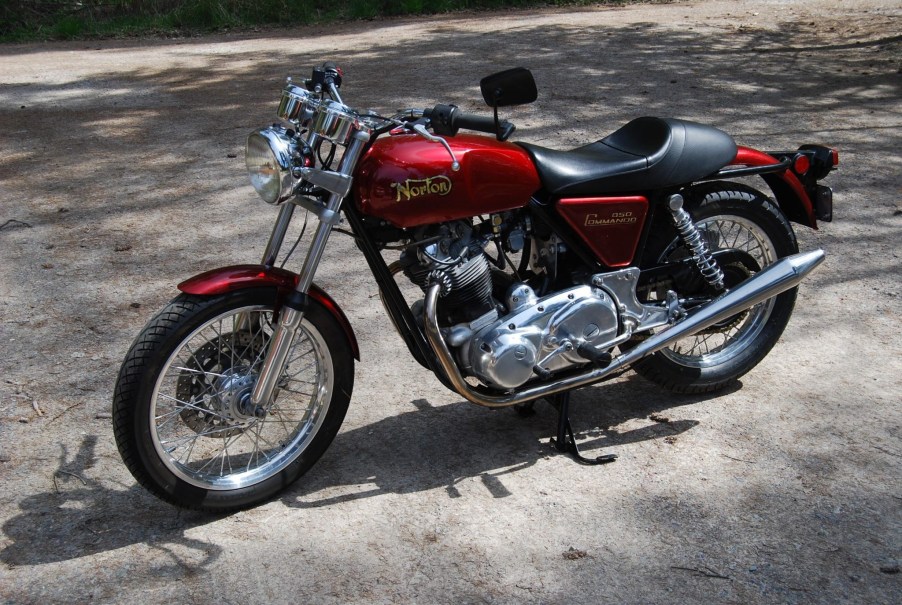
The Norton Commando Is an Overlooked Triumph Bonneville Rival
Although other bikemakers make retro-styled motorcycles, Triumph has one of the most extensive lineups of such models. There’s the Thruxton café racer, the off-road-capable Scrambler, and perhaps most iconic, the Triumph Bonneville. Today, there are other brands, like Royal Enfield, which are starting to offer alternatives to the British bike. But back in the 60s and 70s, the Bonneville had a rival that many forget about: the Norton Commando.
Norton Commando history
In the years leading up to WWII, Norton was one of the most successful British motorcycle companies. It had repeatedly won the Isle of Man TT, enough that a Norton on the podium was basically a foregone conclusion. One of its frames, the famous ‘Featherbed’, is still used, albeit in modern form, by Indiana-based Janus Motorcycles.
After WWII, Norton continued to have some racing success. In 1961, Cycle World reports, famed racer Mike ‘the Bike’ Hailwood won the Isle of Man TT on a 500cc Norton. However, as Bennetts explains, both Norton and Triumph were starting to fall behind the Japanese competition, especially in the engine department. Honda was about to reveal the 750cc four-cylinder CB750, the first motorcycle called a ‘superbike.’
Triumph’s solution, The Drive reports, was the Triumph Bonneville. It had a 650cc twin-cylinder, making 46 hp and giving a top speed of 108 mph. This was updated in 1968 with improved electrics, better steering and suspension, and front disc brakes. Norton tried to counter with its 750cc twin-cylinder Atlas, Bonhams reports, but the engine vibrations overwhelmed the frame.

Making matters worse, Norton didn’t have a lot of money left to improve the Atlas. Instead, Cycle World explains, to make the 1968 Norton Commando 750, engineers mounted the Atlas’ engine on shimmed rubber ‘Isolastic’ mounts. The engine still vibrated, but now the rider didn’t feel it as much.
What’s the Norton Commando like to ride?
On paper, the Norton Commando doesn’t seem quite as impressive as the Triumph Bonneville, the Honda CB750, or other contemporary motorcycles. The Commando 750 still had drum brakes on both wheels and 4-speed transmission, for example. Though, admittedly, a front disc arrived for 1971. But, although Norton gave the Commando an electric starter in 1975, Cycle World’s Peter Egan—who’s owned 4—reports it was too weak to actually start the bike.
However, Cycle World reports that the Norton Commando is one of the few 70s British bikes that can still keep up with traffic. Its 750cc two-cylinder put out 58 hp and made it about 10 mph faster than the Triumph Bonneville. In 1973, Norton introduced the Commando 850, with an updated and more-powerful 828cc two-cylinder.
On top of more power and speed, Popular Mechanics and Petrolicious report the Norton Commando handled better than the Triumph Bonneville. The Commando’s engine was tilted forward compared to the Atlas, which improved the center-of-gravity. Cycle World reports the Norton Commando 850 was also nimbler than the contemporary BMW R90S and had more controllable brakes. While the R90S is the better touring bike, the Commando is the better sportbike.
Pricing and availability
Unfortunately, the Norton Commando also suffered from severe British-bike-itis, i.e. unreliability. Many of the original engine parts, Petrolicious reports, were machined to tolerances described as “close-enough [sic].” Their original electrics are also prone to failure, and their carburetors and engines tend to leak. Also, screws and bolts can wiggle loose, even with those Isolastic engine mounts.

However, Cycle World reports there are quite a few Norton Commando fans and part-suppliers around. And modern replacement parts can drastically improve these motorcycles’ reliability. In addition, Commandos are fairly inexpensive. Bonhams has sold several for about $7000. And on Bring a Trailer, prices rarely exceed $10,000; the 850 models tend to be more valuable.
Follow more updates from MotorBiscuit on our Facebook page.


